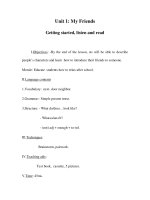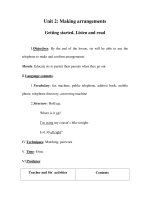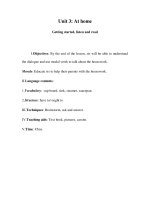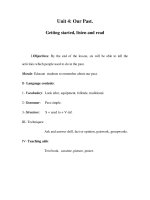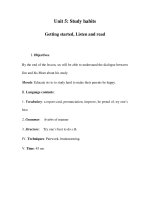Period 7 UNIT 2: CLOTHING Lesson1: Getting started, Listen and read I. Aims of the lesson : By the potx
Bạn đang xem bản rút gọn của tài liệu. Xem và tải ngay bản đầy đủ của tài liệu tại đây (4.47 MB, 6 trang )
Period 7
UNIT 2: CLOTHING
Lesson1: Getting started, Listen and read
I. Aims of the lesson :
By the end of the lesson, Ss will know some more about ao dai the
traditional dress of Vietnamese women. And understand more about
the present perfect
Review the passive voice .
II. Teaching aids:
Textbook, board, record, tape. pictures,…
IV. Teaching steps:
Teacher’s tasks Students’ tasks Display on the board
I. Warm up:
*Quiz
- Divides class into 2groups.
Asks them to look at the
clothes people are wearing
and take turn to decide
where each person comes.
Answers:
a- She comes
from Japan
b- She comes
from Vietnam
c- He comes
T: Where does the woman in
picture a. come from?
S1: She comes from Japan
T: How do you know?
S1: Because she is wearing
a kimono
from Scotland
(UK)
d- She comes
from India
e- She comes
from the USA
f- She comes
from Arabia
II. New lesson
1. Presentation:
*New words:
- a poet: (n) (examples):
-to slit: (v) (explanation):
-inspiration: (n) (translation):
-
ethnicminorites:(n)(example)
-a pattern: (n) ( picture) hoa
văn
- Check :What and where
* Presentation the text:
Sets the scene: You are
- Listen and
guess the words
from T's
eliciting
Repeat in
chorus
individually
Check :What
1. Vocabs:
- a poet: (n): Nhà thơ
-to slit: (v): xẻ
-inspiration: (n): cảm hứng
-ethnic minorites:(n) các dân tộc
thiếu số
a pattern: (n) hoa văn
going to read a text about the
traditional dress of VN.
Aks students to read the text
individually
* Gap fill:
Asks students to read the
text again to do exercises a
page 14.
? Work in pairs
Gives feed back
*Comprehension questions
- Asks Ss to read the text
again to prepare the answers
for the questions
- Runs throughout the
questions.
? Work in 2 groups and play
lucky numbers game
Gives feed back
* Model sentences:
and where
Listen
Read the text
individually
Read the text
again and
complete the
sentences,
using the
information
from the text
Read the text
again to
prepare the
answers
2. Gap fill:
1. poem, novels, and songs
2. long tunic with slits up the
sides worn over loose pants
3. to wear model clothing at
work
4. printing lines of poetry on it
5. symbols such as suns, stars,
crosses and stripes
4. Comprehension questions
(answer key)
1. Traditionally, men and woman
used to wear the Ao dai.
2. Because it’s more convenient
3. They have printed lines of
poetry on it or have added
symbol such as sun, stars,
crosses, and stripes to the ao dai.
?Nowadays,who wear Ao
dai?
Yes.
So I can say “ Ao dai is
worn by the women” and
this is the passive form of
“women wear ao dai”
?Give form
Play lucky
number
Listen and
answer the
question
“Women wear
Ao dai”
Look at the
models and
give the form
5. Model sentences:
Women wear Ao dai
Ao dai is worn by the
women
Active: S + V + O
Passive: S +to be + PP +( by
+O)
Động từ chính của câu chủ động
ở thì nào thì tobe phải chia ở thì
đó
More examples:
I cleaned the board
The board was cleaned by
me
3. Practice:
* Words cue drill:
1. They modernize the ao
dai nowadays.
2.Nowaday, only women
wear ao dai.
3.They added these patterns
to the ao dai.
4.They make the ao dai from
silk.
Change the
sentences in to
passive voice
*Words cue drill:
Change the sentences in to
passive voice.
1.The ao dai is modernized
nowadays
2.The ao dai is worn by women
nowadays
3.The ao dai is added these
patterns
4.The ao dai is made from silk.
4. Further practice
Asks Ss to do ex 4 in
Langguage fovus(page 21)
do ex 4 in
Langguage
focus
* Consolidation.
New words, Aodai.
Passive form…
IV. Home work:
? Do the exercises 5-6 in exercise books



